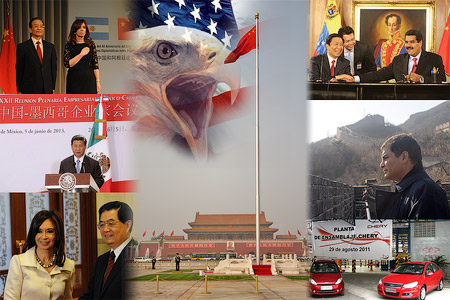Latin America between China and the U.S.
August 25, 2013

In 2010 Beijing signed contracts with Argentina regarding investments of 10 billion dollars in the transportation sector. In that same year the PRC concluded several agreements with Colombia on collaboration in the area of tourism. In 2011 an intergovernmental agreement was signed with Bolivia on collaboration in the space industry for a period of 5 years. In 2012 barriers were removed from the path of imports of food products from Chile to the PRC. Former Chilean President Eduardo Frei Ruiz-Tagle emphasized at that time that with Europe in the grip of financial crisis and economic growth slowing in the United States, reorienting the Chilean economy on Asia is of strategic significance. Other countries which have spoken of the strategic importance of collaboration with Beijing include Cuba, Peru, Ecuador, Uruguay, Brazil, Costa Rica... The small island states of the Caribbean basin do not escape the attention of Beijing either. For example, in May 2013 Chinese President Xi Jinping made an official visit to Trinidad and Tobago, a state which is small in size but significant in its natural gas reserves.
Between 2005 and 2011 China provided South American states with loans amounting to over $75 billion while importing oil, copper and iron from them. Experts predict that by 2015 China will crowd the European Union out of the South American economy, making Beijing the second most important trade partner in the region after the U.S. Even now, while exports from Latin America to the U.S. are falling, exports to China have risen by 5%. After the Asia-Pacific region, Latin America is the second largest region by volume of investments for China.
Economic collaboration with Latin American countries reinforces China's food and energy security, provides significant market outlets for Chinese goods, and in the long term makes it possible to reconfigure the geopolitical space in America's «backyard» to China's advantage. That does not mean that Beijing and its Latin American partners have no disagreements, but the disagreements lie purely in the economic sphere, with no taint of politics. The cornerstone of Beijing's foreign policy is the tactic of smoothing disagreements which could hamper the advancement of the Celestial Empire’s economic interests and indifference to ideological labels used by the West in foreign policy («democracy», «human rights», etc.). Such an approach is more effective than the pressure tactics employed by the West.
It seems that under these circumstances, while Washington is not risking taking harsh countermeasures against China's penetration into Latin America, it is trying to do everything it can to limit the influence of the PRC to the economy without allowing it to spread to the political sphere. However, it is unlikely that in the long term China will limit itself strictly to trade relations with the states of Latin America. For example, under the terms of a loan from China, all kinds of vehicles for the needs of the army have been supplied to Bolivia, and Beijing intends to continue military technical cooperation with South American countries.
Furthermore, some infrastructure projects initiated by the Chinese will contribute not only to the economic transformation of the continent, but to its political transformation as well. For example, the project for building an interoceanic Nicaraguan canal at a cost of $40 billion which would connect the Pacific Ocean with the Caribbean Sea is already being called the «second Panama Canal». Much is being said about Beijing's intention to build a railroad line that would connect the Pacific and Atlantic Oceans. The participation of private Chinese companies in these projects is also anticipated. If the project is implemented, Nicaragua could become an important logistics center of the Southern Hemisphere, and the PRC would gain leverage over third-party countries wishing to use the canal for trade and economic relations.
China's growing economic power forces it to search for market outlets far beyond the borders of the Celestial Empire. In connection with this, the coincidence of interest between the Chinese government and Chinese private business is of great significance, especially in an international situation where the «only superpower», the U.S., is experiencing difficulties in various parts of the world; the U.S. economy is not keeping up with its policy; and the demographic situation in the United States is changing to the disadvantage of the White Anglo-Saxon population. And while not long ago the geographical range of the rivalry between the PRC and the United States was limited to the Asia Pacific region, today signs of this rivalry can be seen everywhere - from Europe and Asia to Africa and Latin America.